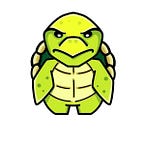Loggerhead Turtle
Like other marine turtle species, Loggerheads prefer the coastal waters of coral reefs, bays and estuaries in tropical and subtropical areas, but have been known to travel hundreds of miles out to sea. Much of the nesting is concentrated in two areas, Masirah Island, Oman and the south-eastern coast of the U.S. However, there are two breeding populations in Australia. One is centred around the southern Great Barrier Reef in eastern Australia and the other in Western Australia near the Ningaloo coast. The main rookeries in eastern Australia are at Mon Repos and adjacent beaches on the mainland.
Loggerhead turtles can be identified by their reddish-brown, heart shaped carapace and a plastron (under-belly) that is yellow-brown in colour. Other distinguishing features are their large heads, with heavy, strong jaws. Hatchlings have dark brown carapaces with pale brown flippers. As they grow, the carapace will turn a lighter shade of brown. Unlike green turtles, they have five lateral scutes down their carapace. Adult loggerhead turtles can weigh up to 115 kg and reach a length of 90 cm.
Although they are a primarily carnivorous marine turtle species, they have been known to feed on algae and sea grasses.
Nesting season starts in late October, lasting till early December in the south-eastern Queensland population. After nesting, it takes around 55–60 days for the nest to hatch.
Like many marine turtle species, females will travel thousands of miles to return to the beach they hatched on to lay their eggs.
Main Threats:
The main threats to Loggerhead sea turtles are marine pollution (plastics, fishing net, etc.), by-catch from fishing, and habitat destruction.
Source https://www.seaturtlefoundation.org
Turtle is a Community token dedicated to raising money for environmental causes.
Website: www.Turtlelute.com
Telegram ~ https://t.me/Turtlelute
Twitter ~ https://twitter.com/turtlelute
